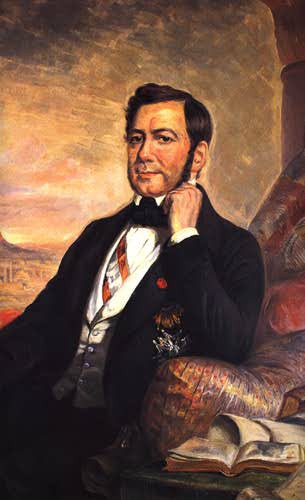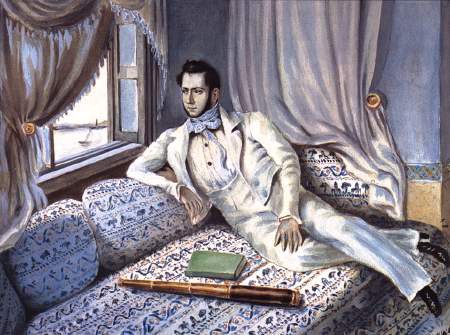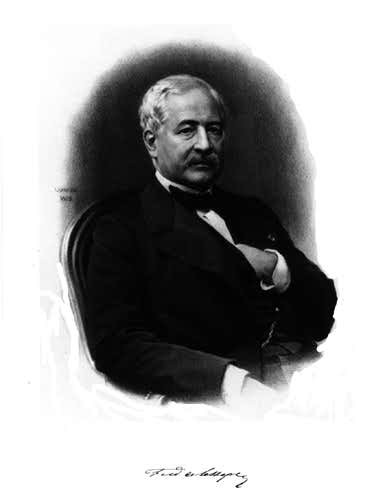Creator of the Suez Canal. Born in Versailles, into a family raised to the nobility in 1777, son of Mathieu de Lesseps, French Consul, and nephew of Barthélemy de Lesseps, one of the members of the La Pérouse expedition and subsequently French Consul General in St Petersburg during the First Empire. Ferdinand, who was schooled at the Collège Henri-IV and then studied law, took up a career in the diplomatic service in his turn. He was made Vice-Consul in Alexandria in 1832 and Consul in Cairo the following year.
During this first period of residence in Egypt, Ferdinand de Lesseps read the Description of Egypt by the engineer Le Père, who had accompanied Bonaparte on his campaign in this country. On looking at Le Père's construction projects, de Lesseps was inspired with the idea of a canal linking the Mediterranean and the Red Sea.
However he was then appointed Consul in Rotterdam, and after that in Barcelona, where the protection he provided to civilians during the uprising of 1842 earned him the cordon of Officer of the Légion d'honneur. In 1848, de Lesseps was appointed French Minister in Madrid by Lamartine.
 The following year, he was sent to Rome to negotiate an agreement between the leaders of the Roman Republic and General Oudinot's French troops. But the Legislature ordered the suppression of the Roman Republic and de Lesseps was abruptly repudiated and recalled, his career as a diplomat seemingly in ruins. He withdrew from public life to live in semi-retirement in the Indre for nearly five years.
The following year, he was sent to Rome to negotiate an agreement between the leaders of the Roman Republic and General Oudinot's French troops. But the Legislature ordered the suppression of the Roman Republic and de Lesseps was abruptly repudiated and recalled, his career as a diplomat seemingly in ruins. He withdrew from public life to live in semi-retirement in the Indre for nearly five years.
In 1854, learning of the accession of Mohammed Said, an old friend of his, to the post of Viceroy of Egypt, he hastened to Cairo and obtained from the new sovereign “the power to found and head a universal company for the digging of a channel through the Suez isthmus and the operational development of a canal between the two seas”.
This on condition that it was approved by the Sultan of Constantinople, the de facto ruler of Egypt. The project was submitted to and passed by an international scientific commission, and preparatory exploration was begun immmediately. However the project ran into serious difficulties, principally of a diplomatic nature.
 Firstly in Constantinople, where de Lesseps attempted in vain to secure the approval of the Ottoman government in 1855, doubtlessly in view of the attitude of the English who were afraid the French might threaten the East Indies trade route. Then de Lesseps left for England where, for want of swaying Prime Minister Palmerston, he undertook to win round the chambers of commerce. In 1858, a floatation enabled him to collect a hundred million Francs from 20,000 investors, mainly French, without the support of the major banks. He thus founded the Universal Company of the Suez Maritime Canal. But even once work on digging the canal had begun, the controversy continued.
Firstly in Constantinople, where de Lesseps attempted in vain to secure the approval of the Ottoman government in 1855, doubtlessly in view of the attitude of the English who were afraid the French might threaten the East Indies trade route. Then de Lesseps left for England where, for want of swaying Prime Minister Palmerston, he undertook to win round the chambers of commerce. In 1858, a floatation enabled him to collect a hundred million Francs from 20,000 investors, mainly French, without the support of the major banks. He thus founded the Universal Company of the Suez Maritime Canal. But even once work on digging the canal had begun, the controversy continued.
The British press denounced the corvée which provided the necessary labour. In 1863 Said died and was succeeded by Ismail who ordered work to be stopped the following year. In spite of England, the Ottoman government, the Viceroy and the Canal company appealed to Napoleon III as arbitrator to settle their differences. Morny was opposed to de Lesseps who nonetheless was able to count on the support of Empress Eugénie, his second cousin. The verdict delivered by the Emperor on 6 July 1864 enabled the future of the Company to be secured. To make up for the abolition of hard labour, workers were brought in from Europe and, more importantly, modern materials were used to dig the canal.
Further issues of securities made it possible for work to continue, after it had been slowed down by a cholera epidemic. Finally, the Sultan of Constantinople issued the firman sanctioning the company in 1865, and the following year Great Britain agreed to acknowledge its existence officially.
Work was successfully completed in 1869. The waters of the Mediterranean and the Red Sea were united on 15 August, and on 17 November the canal was officially inaugurated with magnificent ceremony in the presence of numerous world leaders. At the head of the flotilla was the Eagle bearing the colours of France. At his side, Empress Eugénie accompanied Ferdinand de Lesseps, President of the Suez Canal Company, as he savoured his triumph. It was after all thanks to his energy, dynamism and negotiating skills, and his managing to find the support necessary to overcome all opposition, that this great work was accomplished. When the war of 1870 broke out, de Lesseps was in London being received by Queen Victoria.
Under the Third Republic, he became “the Great Frenchman”, “the most famous man in the world”. His interest turned to the exploration of Africa and, among other things, to the expeditions of Savorgnan of Brazza. In 1884, he was elected to the Académie Française. He played an active role in assuring a successful outcome for the Suez Canal Company, for example when England bought up company shares owned by Ismail in 1879, or during the Arabi Pasha revolt in 1882, and managed to conclude a deal between the Company and British shipowners over rates payable on passage through the canal. However in 1878, on obtaining a concession from the Columbian government to build the Panama Canal, he embarked upon a new and high-risk venture.
Geographical and financial difficulties along with the opposition of the United States brought about the failure of the project, ending in a serious political and financial scandal (1888-1892). Ferdinand, sentenced to five years in prison in 1893, died the following year, ten years before the Panama Canal was opened under the aegis of the United States.
Alain Plessis


